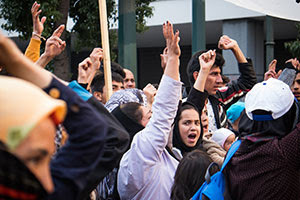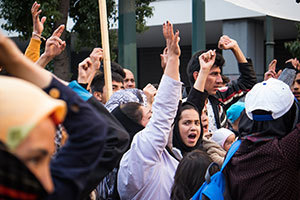

Protests and demonstrations are an integral part of democracy, especially during election years. Data from these events give researchers insight into areas ranging from policy to social movements to religion. Historically, the best way to collect protest-event data has been to scour newspaper reports, a method that researchers have long admitted can lead to flawed or skewed information.
Now, researchers at the University of Notre Dame have created the first-ever nationally representative sample of protest events, giving researchers the opportunity to draw from a more complete picture of demonstrations around the country.
Kraig Beyerlein, associate professor of sociology at Notre Dame, and his team used hypernetwork sampling to create a catalog of protest events that occurred throughout the United States between the summer of 2010 and the summer of 2011, including very large events such as Jon Stewart’s “Rally to Restore Sanity” and Glenn Beck’s “Rally to Restore Honor” as well as numerous smaller protests. Beyerlein’s team surveyed more than 25,000 people around the United States and found over 1,000 who had participated in a protest or demonstration in that time span. Based on protesters’ firsthand accounts, information such as size, cause, target, tactics and location about protest events was recorded.
The novelty of the project, called the National Study of Protest Events (NSPE), allows researchers to answer previously unknown questions about protest events, thus opening the door for new discoveries in the field of contentious politics and social movements. The advantage of the NSPE is that the national representation of the protest data offers researchers a more comprehensive look at these events over what newspapers can offer, since media outlets are free to determine which protests to report on.
 Beyerlein
Beyerlein
“Since newspaper coverage of protest events is the primary way scholars have studied these events in the past, we compared the NSPE to it,” Beyerlein said. He and his team compared the NSPE data with reports from The New York Times, The Washington Post, Chicago Tribune and Los Angeles Times. “Differences in the types of protests between the NSPE and newspaper coverage of protests were expected, but the magnitude of some of them was surprising.”
In a paper published online Monday (Oct. 17) in Sociological Methods and Research, Beyerlein and his team show that not only were the protest events captured in the NSPE considerably smaller than those reported in newspapers – the average event size in the NSPE was 61 protesters, compared to the newspaper average of 2,983 – but the events were also spread out over a far greater number of different cities, both large and small, and were held for a range of different causes from abortion to drug policy to health care. Newspapers, however, were more likely to report protests rallying around the causes of race, religion and, especially, elections, Beyerlein said.
The NSPE was partially funded by a grant from the Science of Generosity initiative. Peter Barwis, Bryant Crubaugh and Cole Carnesecca, all sociology graduate students at the time of the NSPE project, are co-authors on the paper, available online here: http://smr.sagepub.com/content/early/2016/10/14/0049124116661574.abstract. More information about the NSPE database is available at nspe.nd.edu.
Contact: Kraig Beyerlein, 574-631-8517, kbeyerl1@nd.edu
Originally published by at news.nd.edu on October 18, 2016.